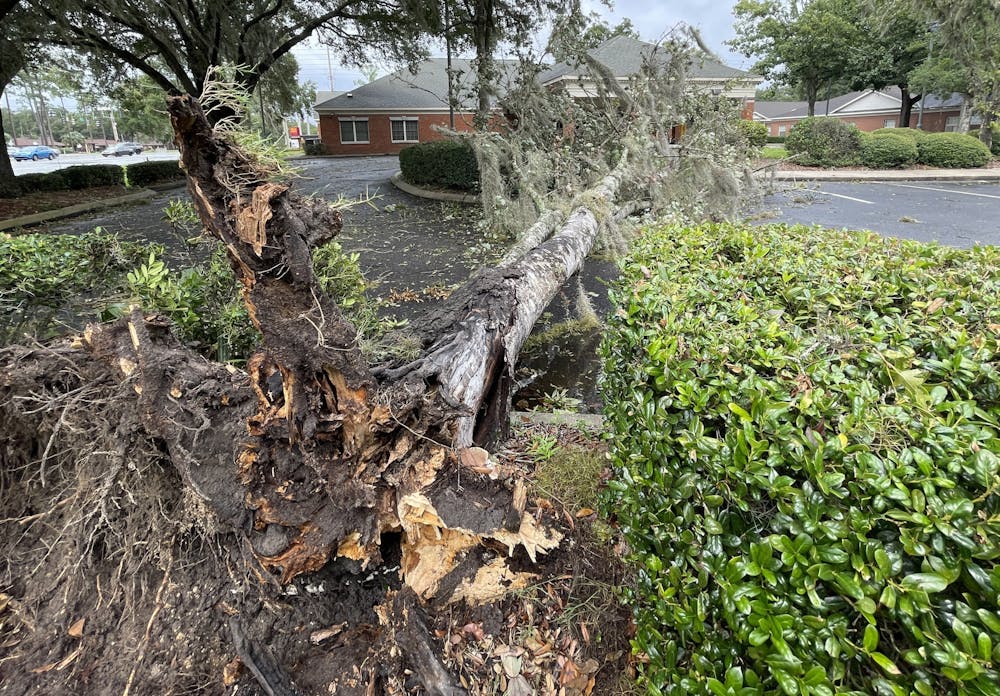As Florida’s Big Bend communities recover from the devastating impacts of Hurricane Idalia, the Alachua County community is grateful to not have met the storm's eye.
Hurricane Idalia made landfall in Keaton Beach as a high Category 3 storm Aug. 30 at 7:45 a.m. With maximum sustained winds at 125 mph, Idalia brought heavy rains and over 6 feet of storm surge to northwest Florida’s coastal cities.
Alachua County suffered minor damages. Several trees and power lines came down across Gainesville, and some roadways were blocked.
There was one death in Alachua County attributed to Idalia, according to a Florida Highway Patrol Official press release. A 59-year-old Gainesville man was involved in a car crash on State Road 20 while the storm’s outer bands swept through the city.
About 14,500 Gainesville Regional Utilities customers lost power the day of the storm, said GRU Communications Director David Warm. All outages were fixed within the same day.
During Hurricane Idalia, deputy sheriffs in Alachua County staffed emergency shelters, increased patrols and were deployed to help with downed power lines. Several members of the Alachua County Sheriff’s Office also traveled to the Big Bend region to help with relief efforts, ACSO spokesperson Chris Sims said.
Alachua County, which was originally forecast to get a direct hit from Idalia, was spared when the storm shifted west. If it hadn’t, Gainesville could have seen severe damage, Mayor Harvey Ward said.
“There would very likely have been loss of life and tremendous property damage,” he said.
Ward was proud of how the community and the city responded to the hurricane. He appreciated the community listening to local officials and staying indoors, he said, and was impressed at the response from the city’s emergency operations team.
UF impact
UF also avoided damage by the shift in Hurricane Idalia’s path, UF Director of Emergency Management Kenneth Allen said. Although UF closed its campus from noon Aug. 29 through Aug. 30, the university resumed full operations by Aug. 31.
“Even that little bit of shift over to the west dramatically improved our outlook,” he said.
UF Southwest Recreation Center also opened as an emergency shelter on campus. Fewer than 10 guests sheltered there due to the storm’s minimal impact, he added.
GRACE Marketplace
Ahead of the storm, Alachua County opened emergency shelters. One of the emergency shelters, located at local homeless shelter GRACE Marketplace, took in 150 residents on Aug. 30. GRACE, which has a normal capacity of 129 beds, was open to taking in up to 300 residents, executive director Jon DeCarmine said.
GRACE also ensured that residents in its housing programs were stocked with emergency supplies. What’s considered a mild hurricane to most people can be a lot more daunting to those who are only protected by a tent or a blanket, DeCarmine said.
“Making sure that we’re available to provide shelter to people in crisis is what we do every day,” he said.
Damage statewide
While Alachua County didn’t experience severe damage, parts of northwest Florida were devastated by the storm.
Cedar Key, which took a direct hit from Idalia, is one of the areas in Florida that suffered the most damage. UF IFAS has a nature coast biological station in Cedar Key, which didn’t respond for comment. Cedar Key will be recovering for a long time, said Carrie Stevenson, an IFAS coastal sustainability agent in Escambia County.
“Islands are often cut through and dunes may take decades to rebuild,” Stevenson said.
Hurricane Idalia is the latest storm in an above-average hurricane season. In an average season, there are 14 named storms. Since June 1, there have been 11, UF Chief Meteorologist Jeffrey George said, which could be due to climate change — as warming ocean temperatures help fuel hurricanes.
“With sea level rise caused by climate change, we will also see higher storm surges and
increased flooding in coastal and riverine areas,” Stevenson said in an email.
While ecosystems and human economies can bounce back from a hurricane, Stevenson said they’re not prepared to weather multiple severe storms every year. Trees in urban environments that aren’t demolished during a storm are still more vulnerable to disease and insect infestation.
With fewer trees in a city, there’s less chance to mitigate overly hot temperatures.
“That beautiful tree canopy around town could be devastated by intense winds,” Stevenson said.
Contact Kylie Williams at kwilliams@alligator.org. Follow her on Twitter @KylieWilliams99
Kylie Williams is the Spring 2025 Digital Managing Editor and a third-year journalism major. She has also worked as the enterprise editor and the environmental enterprise reporter. In her free time, she can be found reading, baking or watching reality TV with her cat.






